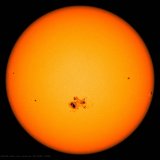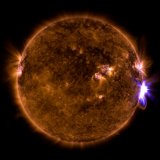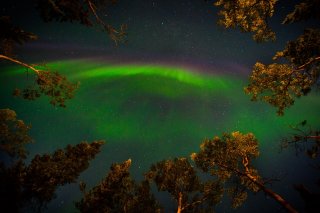Radiation From Solar Activity
- The Sun sometimes emits cosmic radiation during various solar events.
- Solar events include coronal mass ejections, sunspots, and solar flares.
- Solar events can interfere with communications systems on Earth.
Cosmic radiation is emitted during solar events, including sunspots, solar flares, coronal mass ejections (CMEs) and proton storms. The Earth’s atmosphere works like a shield, keeping out large amounts of this radiation. Cosmic radiation is of particular concern to astronauts and equipment in space.
About Radiation From Solar Activity
Solar flares, CMEs and geomagnetic storms are examples of extreme Sun activity that can send bursts of energy toward Earth. Some of this energy is in the form of ionizing radiation, some of the energy is magnetic energy, and some is ultraviolet radiation.
Sunspots
Source: National Aeronautics and Space Administration (NASA)
Sunspots are very strong magnetic fields on the surface of the Sun. These magnetic fields can become twisted, storing energy like a rubber band. They appear dark on the surface of the Sun, because they are cooler than the surrounding areas. The magnetic fields that create sunspots prevent some of the Sun’s heat from reaching the surface of the Sun. When sunspots interact with each other they cause explosions of energy.
Solar flares are large eruptions of energy coming off the Sun containing several different forms of energy: heat, magnetic energy, and ionizing radiation. The ionizing radiation released during solar flares includes x-rays and gamma rays. These rays of ionizing radiation can damage satellites because they are in space and are not protected by the Earth’s atmosphere. Magnetic energy from solar flares can interrupt radio communication on Earth or damage communications satellites.
Solar Flares
Source: NASA
Solar flares look like bright flashes of light on the Sun. They can last as little as a few minutes, or as long as a few hours.
While solar flares are massive explosions, you still need specialized equipment to see them on the surface of the Sun.
Coronal Mass Ejections (CMEs) and Proton Storms
The most powerful solar flares are huge bursts of x-rays and electrified hot gas called coronal mass ejections (CMEs), which hurl solar matter into space. CMEs can create proton storms. Protons are the positively charged particles from the nucleus of an atom. The explosion that creates the CME accelerates the protons around the Sun to nearly the speed of light. These protons carry dangerous amounts of energy that can break chemical bonds.
The charged particles from a proton storm interact with the atmosphere and cause spectacular changes to the atmosphere known as the aurora borealis or northern lights. The light and x-rays from CMEs reach Earth’s atmosphere in about eight minutes. Usually, the Earth’s atmosphere protects people from proton storms.
Source: U.S. National Park Service (NPS)
Proton storms can interfere with ham radio communication and damage satellites, causing short circuits in electrical systems and shutting down computers. Because powerful proton storms have the potential to cause a lot of damage to technology that we rely on, the National Aeronautics and Space Administration (NASA) tracks the Sun’s activity so we can prepare for large proton storms. NASA also researches new ways to protect astronauts in space, such as those on the International Space Station (ISS).
What You Can Do
- Protect yourself. Radiation from solar activity is a natural part of our environment and does not threaten our health on a day-to-day basis. UV rays from the sun pose a much higher risk to human health. You should take steps to protect yourself from UV radiation, such as wearing sunscreen and protective clothing.



